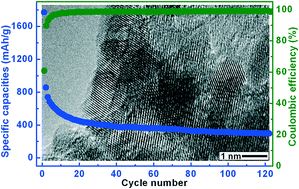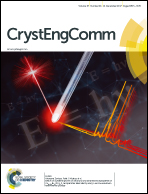A hierarchically structured anatase-titania/indium-tin-oxide nanocomposite as an anodic material for lithium-ion batteries†
Abstract
Anatase phase titanium dioxide (titania) is a potential anodic material for lithium-ion batteries (LIBs), although a serious drawback is its low electrical conductivity. As an attempt to address this issue, a new hierarchically structured nanotubular anatase-titania/indium-tin-oxide (titania/ITO) composite was fabricated. Nanotubular structured anatase titania with a tube wall thickness of ca. 10 nm was firstly synthesized by employing a natural cellulose substance (ordinary laboratory filter paper) as the structural template, and a thin layer of ITO with a thickness of ca. 15 nm composed of fine ITO crystallites (particle sizes ca. 5 nm) was deposited by means of a solvothermal process. When this composite was utilized as an anodic material for LIBs, it delivered a high initial discharge capacity of 1773.4 mA h g−1 and a stable discharge capacity of 298.6 mA h g−1 after 120 charge/discharge processes cycled at 1 C. The unique hierarchical structure of the composite reduced the diffusion length for both electronic and ionic transport, improved the electrode–electrolyte contact area, and enhanced the accommodation of volume expansion and constriction during the lithium ion insertion/extraction process. Hence, improved electrochemical performances such as high reversible capacity, good rate performance and high cycling stability were achieved.



 Please wait while we load your content...
Please wait while we load your content...